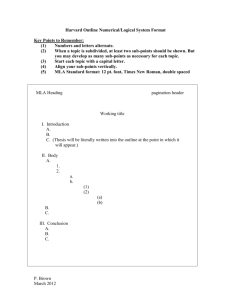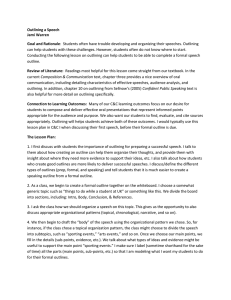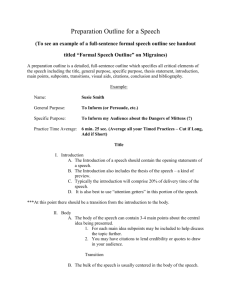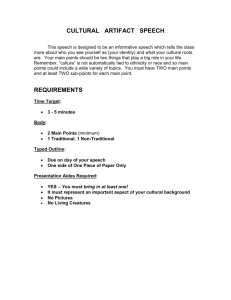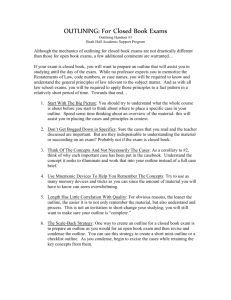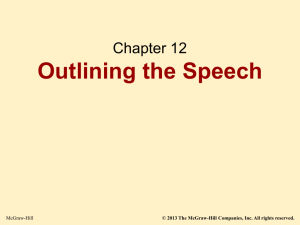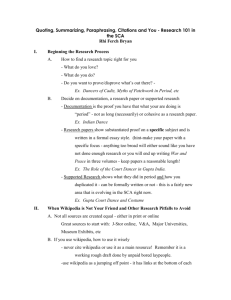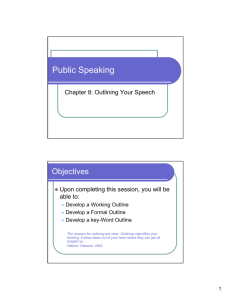ORGANIZING AND OUTLINING YOUR SPEECH
advertisement
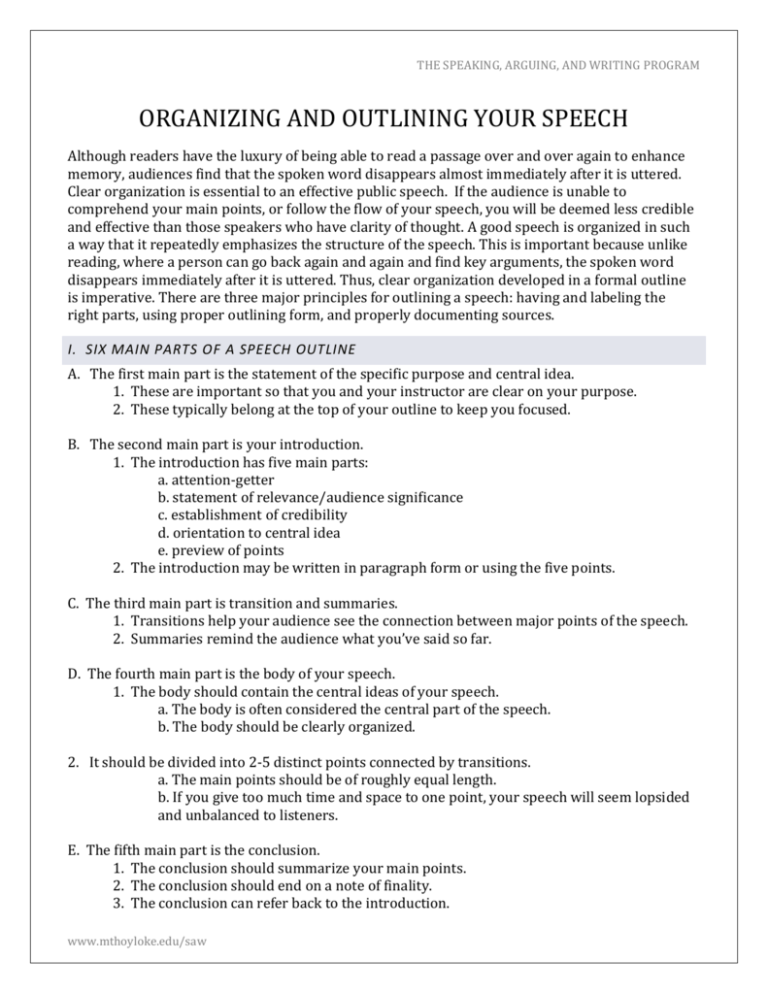
THE SPEAKING, ARGUING, AND WRITING PROGRAM ORGANIZING AND OUTLINING YOUR SPEECH Although readers have the luxury of being able to read a passage over and over again to enhance memory, audiences find that the spoken word disappears almost immediately after it is uttered. Clear organization is essential to an effective public speech. If the audience is unable to comprehend your main points, or follow the flow of your speech, you will be deemed less credible and effective than those speakers who have clarity of thought. A good speech is organized in such a way that it repeatedly emphasizes the structure of the speech. This is important because unlike reading, where a person can go back again and again and find key arguments, the spoken word disappears immediately after it is uttered. Thus, clear organization developed in a formal outline is imperative. There are three major principles for outlining a speech: having and labeling the right parts, using proper outlining form, and properly documenting sources. I. SIX MAIN PARTS OF A SPEECH OUTLINE A. The first main part is the statement of the specific purpose and central idea. 1. These are important so that you and your instructor are clear on your purpose. 2. These typically belong at the top of your outline to keep you focused. B. The second main part is your introduction. 1. The introduction has five main parts: a. attention-getter b. statement of relevance/audience significance c. establishment of credibility d. orientation to central idea e. preview of points 2. The introduction may be written in paragraph form or using the five points. C. The third main part is transition and summaries. 1. Transitions help your audience see the connection between major points of the speech. 2. Summaries remind the audience what you’ve said so far. D. The fourth main part is the body of your speech. 1. The body should contain the central ideas of your speech. a. The body is often considered the central part of the speech. b. The body should be clearly organized. 2. It should be divided into 2-5 distinct points connected by transitions. a. The main points should be of roughly equal length. b. If you give too much time and space to one point, your speech will seem lopsided and unbalanced to listeners. E. The fifth main part is the conclusion. 1. The conclusion should summarize your main points. 2. The conclusion should end on a note of finality. 3. The conclusion can refer back to the introduction. www.mthoyloke.edu/saw THE SPEAKING, ARGUING, AND WRITING PROGRAM F. The sixth main part is the list of works cited. 1. This should follow an accepted citation format (e.g., MLA or APA). 2. This should contain all sources used in the speech itself. II. THREE MAIN RULES FOR PROPER OUTLINING A. The first rule is to clearly label the parts. 1. This ensures the speech is well organized. 2. This helps you to see the structure of the speech. B. The second rule is to use a consistent set of symbols. 1. In the most common set, main points are identified by Roman numerals and are indented equally. 2. Sub-points are identified by capitalized letters and are indented equally. 3. Sub-points and sub-sub-points may be used as well. 4. Using a consistent set of symbols helps to show relationships among the various parts of the speech. C. The third rule is to use parallel structure. 1. Main points and sub-points for a given section should be phrased full sentences that use the same wording whenever possible. 2. This also helps to fix the structure of the speech in your mind. DELIVERING YOUR ORAL PRESENTATION: A. Sources should be identified in the text of the outline. 1. Here, you may use footnotes or parenthetical references after you use a source. a. These should include the author’s name. b. These should include the year of the publication. 2. You must include the page number when you use a direct quote. B. Sources should be listed in a bibliography at the end of the speech. 1. A bibliography is a list of works referenced in the speech. 2. A bibliography must follow a consistent style of citation. a. Common citation styles include MLA, APA, CHICAGO, and CSE. b. Sometimes, you will find that you have consulted a number of sources that you do not actually cite in the speech itself; these may be added in a list of additional sources. Creating an outline for your speech involves at least three main principles: making sure you have all the right parts, using proper outlining form, and accurately documenting sources. This may seem like a lot of work, but it is essential in being able to follow that ageold advice about public speaking: “tell them what you are going to tell them, tell them, and tell them what you’ve told them.” Sources: Lucas, Stephen. The Art of Public Speaking. 9th ed. Boston: McGraw-Hill, 2007. University of Pittsburgh, Communication Across the Curriculum. www.mthoyloke.edu/saw
